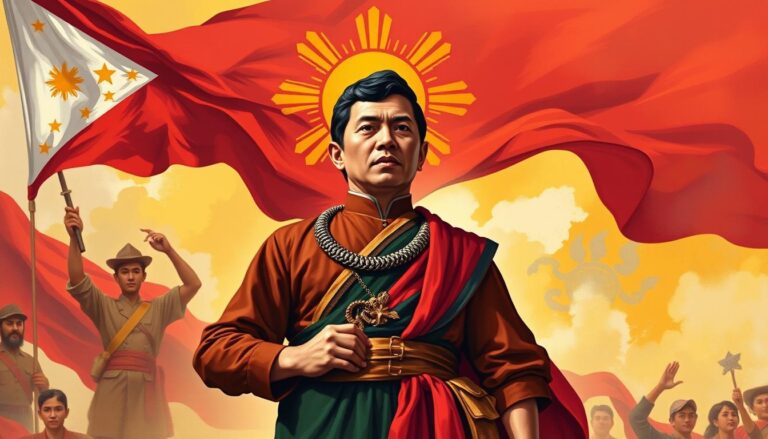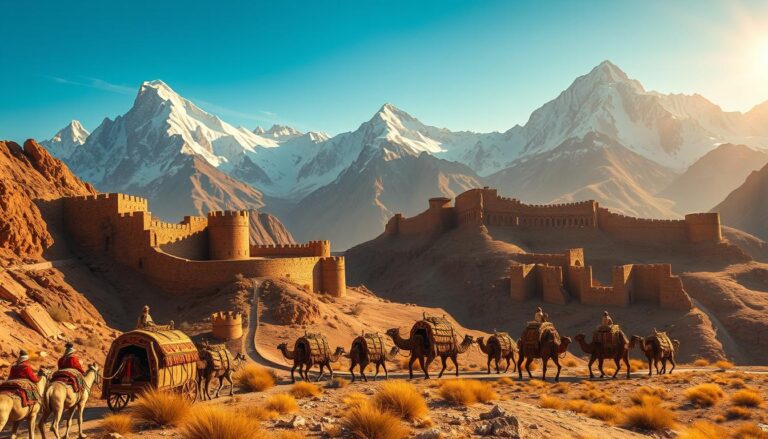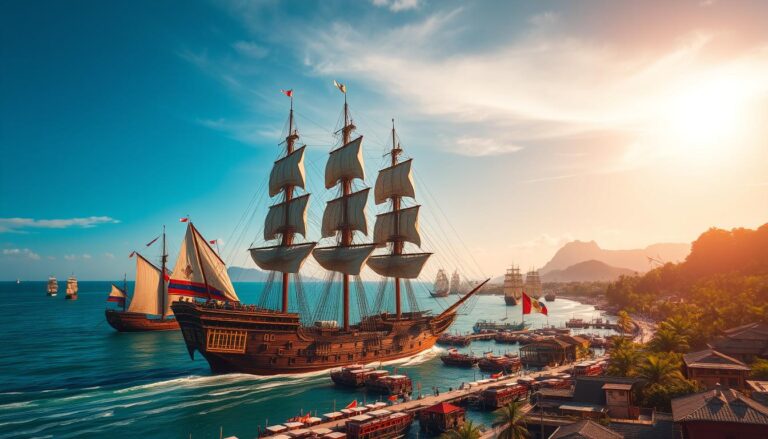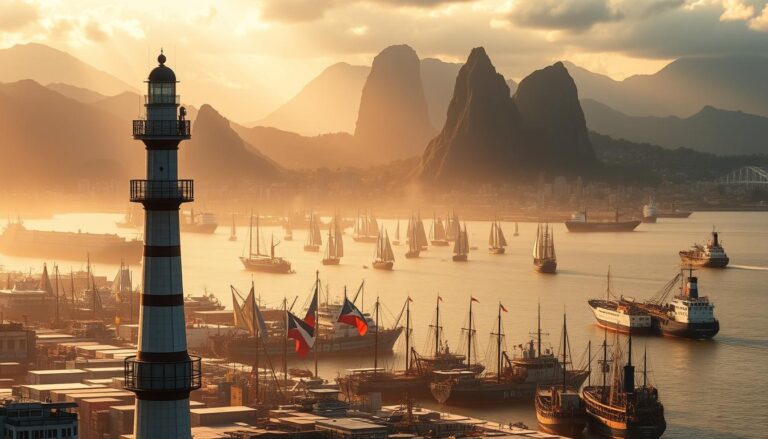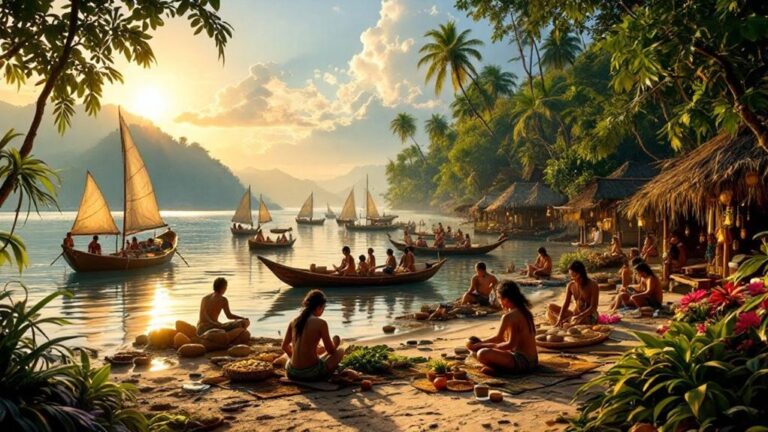The Galleon Trade: Connecting the Philippines to the World
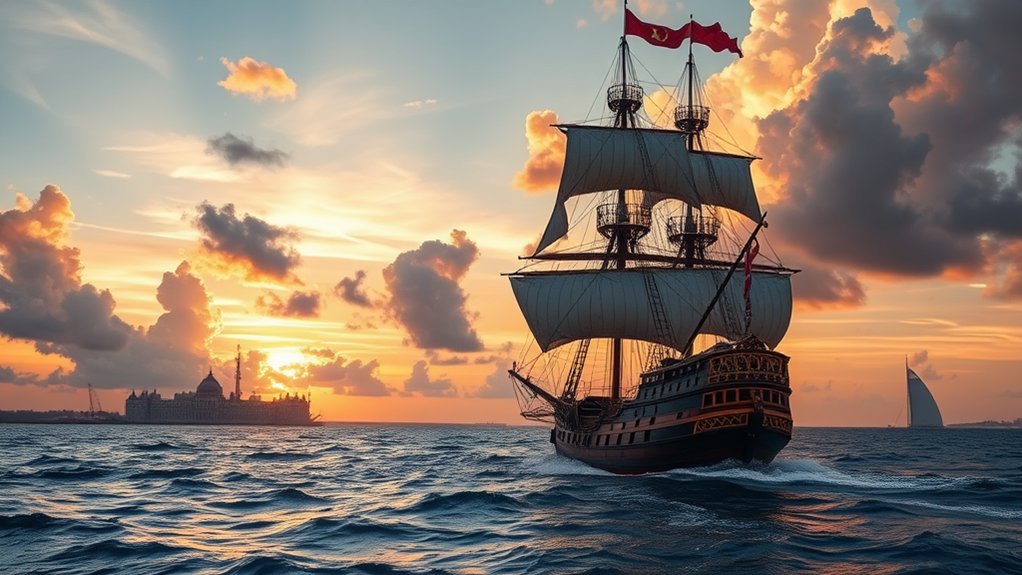
The Manila Galleon Trade, established by Andrés de Urdaneta in 1565, created the first sustained transpacific maritime network connecting Asia, the Americas, and Europe. This 250-year commercial system transformed Manila into Spain's strategic Asian hub, facilitating exchanges of New World silver for Asian luxuries with profits exceeding 400%. The trade fostered deep cultural fusion between societies, influencing language, cuisine, and customs. The complex legacy of this maritime connection continues to shape global commerce and cultural exchange today.
Highlights
- The Galleon Trade established the first transpacific maritime route in 1565, connecting Manila to Acapulco and integrating Asia into global commerce.
- Manila became Spain's strategic Asian hub, facilitating exchanges of Chinese silk, Indonesian spices, and New World silver for 250 years.
- The trade generated massive profits exceeding 400%, with approximately 400 million pesos in silver flowing through between 1570-1840.
- Cultural fusion occurred through crew migrations, language mixing, and shared traditions between Filipino, Mexican, and Spanish societies.
- Philippine hardwoods built the galleons, while Filipino crews dominated maritime operations, showcasing local contributions to global trade.
The Birth of a Global Maritime Network
When Spanish navigator Andrés de Urdaneta charted the eastward route across the Pacific in 1565, he established what would become the Manila Galleon trade route between Acapulco and Manila.
The Manila Galleon route, charted by Urdaneta in 1565, created the first regular transpacific maritime connection linking America and Asia.
This maritime connection marked a historic milestone as the first sustained transoceanic route linking three continents: Asia, Europe, and the Americas.
The establishment of these maritime connections served multiple purposes beyond commerce.
While facilitating the exchange of goods, particularly Asian luxuries for New World silver, the route supported Spanish colonial settlements and enabled missionary expansion throughout the Pacific.
The galleons became instrumental in fostering global trade networks, transforming Manila into a significant international port.
This new maritime system represented an unprecedented scale of intercontinental commerce, establishing a framework for early modern globalization.
The trade's immense profitability was evident through profits of 100-300 percent when cargo was unloaded at Acapulco.
Manila: The Crown Jewel of Spanish Trade
Manila emerged as the Spanish Empire's most strategic Asian trade hub following its establishment as a colonial capital in 1565.
The city's natural harbor and fortified walls of Intramuros provided the perfect foundation for Spanish maritime control, enabling the collection and distribution of goods from China, India, and other Asian regions.
Through the Manila-Acapulco Galleon Trade, Spain successfully connected Asian commerce with the Americas, transforming Manila into a powerful center of global trade that would dominate Pacific commerce for over two centuries. The galleons transported valuable Asian luxury goods to Mexico in exchange for silver, creating immense profits for the Spanish Empire. This trade also facilitated the spread of Catholicism, which became deeply rooted in Filipino culture during the colonial period.
Asian Trade Hub Success
A strategic location along essential maritime routes transformed Manila into the Spanish Empire's most valuable Asian trading hub during the galleon era.
The city's position on Manila Bay enabled Maritime Innovation through the establishment of the Manila-Acapulco galleon trade, connecting Asia with the Americas and Europe in an unprecedented global exchange network.
Trading Alliances flourished as Manila became a nexus for merchants trading Chinese silk, Indonesian spices, and other Asian luxuries for New World silver.
This economic prosperity was particularly significant, as approximately one-third of silver mined in Spanish America was exchanged for Asian goods.
The city's success as a trade hub fostered cultural fusion, blending Filipino, Spanish, Chinese, and Mexican influences in its architecture, cuisine, and traditions, while cementing Manila's position as one of Asia's wealthiest cities. The trade route's prosperity lasted until Mexican independence in 1815 forced its closure and prompted significant economic changes in Manila.
Spanish Control Maritime Power
Spanish dominion over maritime trade routes reached its apex with the establishment of the Manila-Acapulco galleon network in 1565, pioneered by navigators Andrés de Urdaneta and Alonso de Arellano.
Through strategic naval strategies, Spain maintained strict control over this lucrative trade route, implementing a monopoly system that limited annual voyages and regulated cargo flow.
The Spanish Crown's colonial maritime alliances were evident in the construction and operation of the galleons.
While Spanish officers commanded the vessels, Filipino laborers provided essential shipbuilding expertise using local hardwoods and Manila hemp.
The legendary voyage of the San Pedro flagship marked the beginning of this transformative trade relationship between the Philippines and the Americas.
This combination of European naval technology and indigenous resources created formidable ships capable of trans-Pacific journeys.
The Crown's investment in galleon construction and maintenance underscored the route's strategic importance in connecting Asian markets to Spanish colonial interests.
Silver, Silk, and Spices: The Treasures of the Galleons
Silver from the Americas became the cornerstone of the Manila Galleon Trade, with Spanish ships transporting massive quantities across the Pacific to meet Chinese demand.
The trade of this precious metal fundamentally altered the global economy, enabling Spain to acquire vast amounts of Asian luxury goods while providing China with an essential currency for its own commerce.
This circulation of silver created a complex web of economic dependencies, as Mexican mines supplied the metal that powered both European trade ambitions and Asian market dynamics.
Each galleon journey from Acapulco to Manila carried goods valued at 500,000 pesos and endured approximately 120 days at sea.
Silver's Global Economic Impact
The global economy underwent a profound change during the era of the Galleon Trade, as massive quantities of silver from the Americas and Japan flowed into China.
Advances in silver mining techniques, particularly the amalgamation method, enabled Spain to extract and transport unprecedented amounts of silver across the Pacific. This created significant economic disparities that merchants enthusiastically exploited.
China's shift from paper currency to silver, driven by inflation concerns, established it as the primary destination for global silver production, absorbing approximately 100 tons annually between 1600 and 1800. Portuguese traders served as crucial middlemen in Macao, facilitating silver flows between China and other regions.
The Manila Galleon trade facilitated this exchange, with silver from Mexican mines flowing through the Philippines to China in exchange for silk and other commodities.
Asian Luxury Trade Flow
During the height of the Galleon Trade, a vast network of luxury goods flowed between Asia and the Americas, characterized by an intricate exchange of precious commodities.
This economic exchange generated remarkable profit margins of 100-300%, driven by the high demand for Asian luxury goods in New Spain.
The most valuable commodities from Asian trade included:
- Chinese exports: silk, porcelain, lacquerware, and jade
- Indian products: cotton textiles, amber, and ornate rugs
- Southeast Asian goods: spices, particularly cloves and ginger
This extensive trade network not only facilitated economic prosperity but also sparked significant cultural influences across continents.
Chinese porcelain and crafted ivory particularly influenced local manufacturing in Mexico and Guatemala, while textile traditions merged Asian and American designs, exemplifying early globalization through commercial exchange.
Approximately one-third of silver from New Spain and Peru was transported through this trade route to the Far East, establishing a crucial economic link between the Americas and Asia.
Navigating the Pacific: Routes and Maritime Challenges
Spanning over four thousand nautical miles across the Pacific Ocean, the Manila Galleon trade route connected the Philippines to Mexico through a complex network of ocean currents and trade winds.
The journey required sophisticated navigational techniques, with ships sailing northward to catch the Kuroshio Current before following westerly winds to the Americas, typically taking four months to complete.
The route's success relied heavily on shipbuilding innovations, with vessels constructed from Philippine hardwoods and equipped with locally-sourced materials like Ilocos sails and Manila hemp rigging.
Despite these advances, maritime challenges remained significant. Crews faced storms, piracy, and inadequate provisions, while the loss of a single galleon could devastate the Spanish colony's economy.
The return voyage from Acapulco utilized different latitudes, with necessary stops in the Marianas for resupply. Guam and other Mariana Islands provided crucial support by offering fresh provisions and water to passing ships.
Cultural Crossroads: How the Galleon Trade Shaped Societies
Beyond its maritime challenges, galleon trade routes served as powerful conduits for cultural transformation across three continents. The exchange fostered unprecedented cultural fusion between Asian, European, and American societies, fundamentally reshaping local traditions and customs. Manila's port became a bustling hub where 41,400 diverse residents lived and worked together by 1620.
Three significant impacts of this transcultural exchange include:
- Culinary exchange transformed regional cuisines, with Filipino food incorporating Mexican ingredients and indigenous flavors creating unique dishes like sisig tacos.
- Language evolution occurred as Spanish terms became integrated into Pacific communities.
- Religious and social customs merged, creating unique festivals and celebrations.
The trade's influence extended beyond commerce, leaving lasting imprints on architecture, fashion, and artistic expression.
Maritime trade routes shaped more than just economies – they fundamentally transformed the cultural fabric of societies through art, style, and design.
Communities along trade routes adopted new agricultural practices, embracing crops like corn and tobacco. This cultural intermingling created diverse societies whose legacy continues in modern celebrations, cuisine, and artistic traditions.
The Economic Engine of Spanish Colonial Power
The Manila Galleon trade established a crucial economic corridor that transported massive quantities of silver from the Americas to East Asia, particularly China, where the metal commanded premium prices.
This silver-based commerce generated extraordinary profits for Spanish colonial merchants, with returns often exceeding 400% on Chinese luxury goods like silk and porcelain.
The resulting wealth consolidated Spanish colonial power while simultaneously strengthening East Asian economies, as the nearly 400 million pesos in silver that flowed through the trade between 1570 and 1840 created lasting economic interdependencies between the Americas, Asia, and Europe. This unprecedented economic success led to the emergence of wealthy merchant classes that began to challenge traditional social hierarchies across East Asia.
Silver's Global Market Impact
During the colonial period, silver emerged as the cornerstone of Spanish imperial power, fundamentally reshaping global trade networks and monetary systems. China's increasing silver demand drove significant price fluctuations across global markets, while Spanish mining operations in Mexico and Bolivia supplied unprecedented volumes of the precious metal.
The impact of Spanish-American silver production manifested in three critical ways:
- Created a standardized international currency through the Spanish peso
- Triggered global inflation as massive quantities entered world markets
- Established new trade routes, particularly the Manila Galleon, connecting Asia and the Americas
This monetary revolution transformed the economic landscape, with Spanish colonies producing over 100,000 tons of silver.
The mercury amalgamation method increased extraction efficiency, while forced labor in mines like Potosí and Zacatecas sustained production levels that dominated global supply.
Colonial Wealth Through Trade
While Spanish colonial power rested on military might, its economic engine operated through an intricate trading system known as the Manila Galleon Trade. Through systematic colonial exploitation, the Spanish Crown established a strict monopoly over trade routes, limiting ships and controlling the flow of goods between Asia and the Americas.
The trade created significant wealth disparities and trade inequalities. While Manila emerged as a global trading hub, facilitating exchanges of Chinese silk, porcelain, and Asian spices for Mexican silver, the benefits primarily accrued to colonial elites.
The Casa de Contratación in Seville tightly regulated commerce, though widespread smuggling emerged in response to these restrictions. The Royal Philippine Company further consolidated control over Chinese and Indian imports, while local economies became increasingly dependent on this trans-Pacific trade network, reinforcing existing social hierarchies within the colonies.
Life Aboard the Manila Galleons
Constructed from resilient Philippine hardwoods like teak and mahogany, Manila galleons set out on grueling four-month voyages between Manila and Acapulco, where crews faced harsh living conditions and high mortality rates.
Daily routines revolved around steering treacherous waters while maintaining crew morale under challenging circumstances.
The most significant challenges facing crews included:
- Severe food shortages, with limited access to salted meats and biscuits
- Widespread disease and malnutrition, particularly scurvy
- Extended periods without landfall, causing physical and psychological strain
The mainly Filipino crew, managed by Spanish officers, averaged 28-29 years in age, though some sailors were as young as eight.
Limited navigational tools meant heavy reliance on astronomical observations and wind patterns, while unpredictable weather and dangerous reefs near the Marianas posed constant threats.
Beyond Trade: Migration and Social Exchange
Beyond its commercial impact, the Manila Galleon Trade sparked significant migration patterns and social transformations that connected Asia with the Americas. Filipino seafarers initiated early labor migration, serving as primary crew members on galleon voyages to New Spain. Indigenous Filipinos also settled in Mexican regions, particularly near Acapulco, establishing lasting cultural exchanges between the two territories. The ancestral domains of these migrants played a crucial role in preserving their cultural identity and traditions in foreign lands.
| Aspect | Impact |
|---|---|
| Workforce | Filipino natives dominated galleon crews |
| Settlement | Indigenous migration to Mexican ports |
| Language | Evolution of shared linguistic elements |
| Cuisine | Fusion of Philippine-Mexican food traditions |
| Society | Formation of shared Hispanic cultural identity |
This transculturation process transformed both regions through the exchange of traditions, languages, and customs, laying the foundation for ongoing migration patterns that continue to influence Philippine society today.
Legacy of the 250-Year Maritime Connection
The Manila Galleon Trade's 250-year maritime connection left an indelible mark on global commerce and cultural exchange that extends far beyond its operational period of 1565-1815.
As the first documented global trade route, it established fundamental patterns for international commerce and cultural integration that continue to influence modern trade practices.
The trade's lasting impact manifested in three significant ways:
The Manila Galleon Trade's enduring influence reshaped global commerce through three distinct channels of lasting transformation.
- Economic transformation through the establishment of cross-continental monetary systems and trade networks
- Cultural fusion evidenced in Filipino cuisine, language, and artistic traditions
- Archaeological discoveries of shipwrecks that provide invaluable insights into historical trading practices
Today, the Galleon Trade's legacy remains visible in the interconnected economic systems, shared cultural heritage, and enduring diplomatic relationships between nations across the Pacific, particularly in regions directly involved in this pioneering maritime network.
Preserving the Maritime Heritage Today
While maritime heritage preservation faces numerous challenges in the modern era, coordinated efforts by national institutions, international organizations, and local communities actively safeguard the historical legacy of the Galleon Trade.
The National Museum of the Philippines, through its Maritime and Underwater Cultural Heritage Division, leads maritime archaeology initiatives, collaborating with international experts like Franck Goddio's team.
Despite the absence of thorough preservation policies and threats from natural hazards and human activities, institutions implement innovative conservation methods and digital documentation strategies.
Global partnerships, including UNESCO initiatives and tri-national efforts with Mexico and Spain, strengthen preservation frameworks.
The establishment of specialized museums and community engagement programs enhances public awareness, while research networks across nations facilitate knowledge exchange in maritime heritage management, ensuring this significant historical legacy endures for future generations.
Frequently Asked Questions
How Many Galleons Were Lost at Sea During the Entire Trade Period?
Historical records indicate approximately 130 galleon shipwrecks occurred throughout the trade period, with the majority of these losses concentrated near the Strait of San Bernardino in the Philippines' treacherous waters.
What Specific Navigational Instruments Did Galleon Pilots Use to Cross the Pacific?
Galleon pilots utilized astrolabes, quadrants, and cross-staffs for celestial navigation, while maritime charts, lead lines, and hour glasses supported navigational techniques. Star charts and spyglasses aided Pacific Ocean crossings.
How Were Filipino Craftsmen Involved in Building and Maintaining the Galleons?
Filipino craftsmen applied traditional craftsmanship techniques in cutting and assembling local materials, particularly hardwoods like molave and teak. They specialized in woodworking, hull construction, and ongoing maintenance of Manila galleons.
What Medical Treatments Were Available for Sick Crew Members During Voyages?
Sailor health relied on basic maritime medicine, including herbal remedies, limited European supplies, and care from friars acting as infirmarians. Treatments combined Western practices with local remedies for common ailments like dysentery and cholera.
Did Any Women Serve as Crew Members or Officers on Galleon Ships?
Historical records show little concrete evidence of women sailors on galleon ships. While women were active in maritime communities, crew dynamics remained primarily male, with no documented cases of female officers during this period.
References
- https://www.philippine-history.org/galleon-trade.htm
- https://en.wikipedia.org/wiki/Manila_galleon
- https://www.britannica.com/technology/Manila-galleon
- https://meryenda.substack.com/p/manila-galleon-trade
- https://www.guampedia.com/manila-galleon-trade-route-la-nao-de-china-a-legacy-in-the-marianas/
- https://www.hispaniccouncil.org/wp-content/uploads/THC-GaleonManila-EN-DIGITAL.pdf
- https://minnesota.universitypressscholarship.com/view/10.5749/minnesota/9780816666645.001.0001/upso-9780816666645-chapter-2
- https://en.wikipedia.org/wiki/History_of_Manila
- https://psl.noaa.gov/spotlight/2004/manila-galleon.html
- https://histofreak.com/manila-through-ages-timeline-of-asias-pearl-of-the-orient/


